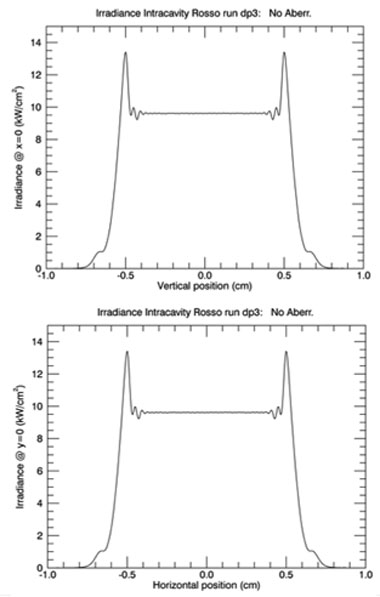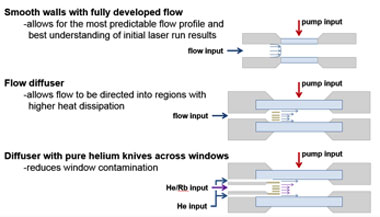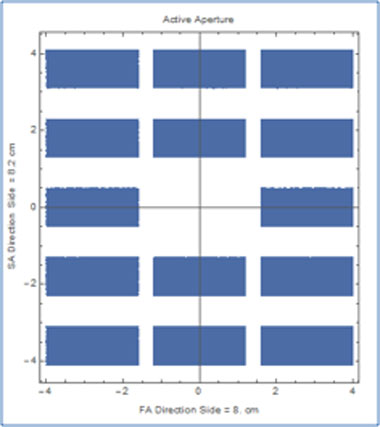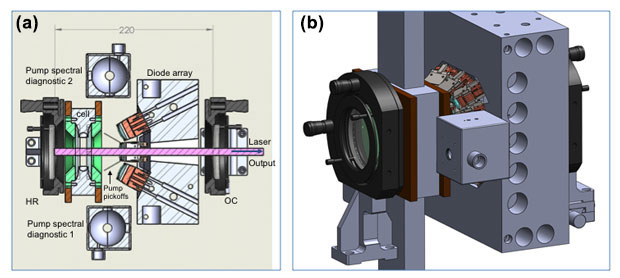Raymond Beach (16-ERD-048)
Abstract
Livermore’s rubidium-based diode-pumped alkali laser (Rb DPAL)1–4 has demonstrated the viability of diode-pumped and advectively cooled gas laser systems as a new family of lasers for applications requiring high average power. While the prospects for such systems look good for some applications, in its presently demonstrated form it has several complexities and disadvantages that if corrected would make such lasers even more attractive, opening them up to a larger range of applications of interest to the Laboratory. Here, we present a new architectural approach to diode-pumped and advectively cooled laser systems that focuses specifically on what we now perceive as the major complexities and disadvantages of the Laboratory's currently operating system. Chief among these complexities and disadvantages are the requirements for waveguides, which have very highly tuned and complicated optical coatings that function to both suppress amplified spontaneous emission and duct pump light along the length of the gain volume. Also, the waveguides are limited by gain apertures that have a high aspect ratio due to the details of the diode pump light delivery, in which the laser cell pump aperture is located in the far field of the laser diode arrays. Further complicating the currently demonstrated architectural path, the use of waveguides presents very challenging thermal engineering requirements, which must be met to achieve good beam quality and high efficiency. Furthermore, the waveguide components themselves are expensive to fabricate and very expensive to optically coat because the appropriate optical coatings (at least at this point in time) are available from only one supplier. The restriction to high-aspect-ratio gain-cell apertures presents challenges for resonator implementation and severely complicates any post-laser optics that would be required in many real systems to provide beam cleanup and wavefront correction. A new approach is needed that eliminates the need for waveguides altogether while simultaneously enabling the use of near-unity-aspect-ratio gain apertures. The analysis and underlying modeling to support such a system design is the subject of this LDRD project, which culminates with the conceptual design of a laboratory-scale system that does not require waveguides and enables near-unity-aspect-ratio gain cells while simultaneously allowing clear and unambiguous assessment of risks associated with the proposed approach. Finally, a discussion of the gain-cell geometry that includes the testing and characterization of a helium knife to provide isolation of the inside window surfaces from Rb and other contaminates is given. In particular, this helium knife feature may be critical to the robust operation of such laser systems and is enabled by our proposed transverse gas-flow geometry.
Background and Research Objectives
Our project is designed to thoroughly vet a new laser configuration concept for diode-pumped advectively cooled gas lasers through a series of modeling studies that culminates in a laboratory-scale design for a system at a significant enough power scale to clearly assess the risks associated with the proposed approach. The modelling work that was proposed and completed as part of this project was divided into four major tasks:
- Model pump delivery. This task involved the generation of detailed ray-trace models for the pump delivery from the diode array into the gain cell. Included in this activity were the generation of coating requirements for the gain cell windows and detailed calculations for the delivered pump overlap with the resonator-defined laser mode.
- Model amplified spontaneous emission. One of the features of the lasers being studied in this work is the extremely high unsaturated gains they are capable of developing. For example, with DPALS this is due to the fully allowed dipole-transitions used.2 One plus of the high gains that can be generated is the compatibility of such systems with simple and robust unstable resonators that can extract the laser power with high beam quality. One issue that was carefully assessed is the control of amplified spontaneous emission and the possibility of closed optical parasitic lasing paths within the gain cell. This portion of the work assessed the proper gain-cell geometries and cell gains that could be safely used in the proposed system. Included was an assessment of both amplified spontaneous emission and optical trapping multipliers within the gain cell.
- Design the laser cell and model the flow characteristics. As already mentioned the laser cell design is much simplified from the approaches being used today in which waveguides are used to confine the pump radiation. For example, cell designs that use transverse vapor/gas flow are possible, and boundary layer problems next to waveguides, which can be detrimental to laser beam quality, are eliminated in waveguide-free cells. The focus of this work was to carefully model and understand the flow characteristics of the gas/vapor through the cell and provide phase profiles across the flow that could be used to assess the beam quality generated with the proposed approach. An additional activity in this task was the investigation of vapor/gas circulators and a recommendation for the circulator that would be most appropriate for use with the proposed laboratory-scale system.
- Generate a point design at the 10-kW level. Drawing on the modeling detailed in Tasks 1–3, this task focused on integrating those results and generating a point design for a ~10 kW laser and carefully assessing and describing any risks that we saw with the proposed system as a result of our modeling activities. For example, one of the activities in this task was the design and specification of the unstable resonator optics that will be used in the proposed system.
Scientific Approach and Accomplishments
Figure 1 outlines the basic architectural approach we are investigating, using a Rb DPAL as a specific example. The elimination of the pump-guiding waveguides within the Rb gain cell is notable: Instead of using guides to duct the pump light through the cell, the pump light freely propagates through the cell.
The diode array is constructed from multiple unit cells (20 bar groupings of diode bars) arranged on a backplane with individual unit cells tilted to point toward the cell-center. In our example, the size of the backplane is chosen to source 25.4 kW of pump power, corresponding to 14 unit cells arranged as shown in Figure 2. Choosing the gain length in the cell to be approximately equal to the diode pump light’s confocal parameter permits the pump light to freely propagate through the cell, thus eliminating the requirement for pump-confining waveguides at the edges of the gain region. Figure 1(a) shows an isometric sketch of our proposed laser concept. Because our approach eliminates the need for waveguides, it also enables transverse gas/vapor flow geometries. In the isometric view in Figure 1(b), the gas inlet and outlet pipes are situated vertically with gas/vapor flowing transversely through the cell.
Figure 4 shows the laser cell concepts that we propose to test and characterize as part of the subscale system. The new architectural approach for diode-pumped and advectively cooled gas lasers involves a different gain-cell geometry from our previous gas laser concepts, such as that used on our presently operational laboratory system. Our conceptual design and development strategy for the gain cell involves a test assembly that provides maximum flexibility in the gas flow profile. The gain cell is reconfigurable in three ways. In the first configuration, the gas flow channel has a constant cross-section over a significant distance extending upstream and downstream of the gain volume such that the flow profile may reliably be assumed to be fully developed as the gas approaches the gain region. This configuration is desirable during initial laser test runs as it minimizes the effects caused by uncertain or unexpected gas flow features. In the second configuration, an array of nozzles is placed at the input to the gain cell. The nozzles are sized and positioned to create a tailored flow profile, concentrating the flow in regions with higher heat dissipation and reducing flow in regions with less dissipation, which results in a more uniform temperature gradient to improve beam quality. In the third configuration, a pure helium source is connected to support helium knives. The pure helium is directed across the window faces to minimize the deposition of alkali compounds and other contaminants. The helium knives may be used in the fully developed flow configuration or with the nozzle arrays.
The pump irradiance profiles, as depicted in Figure 3 are then used as inputs to our laser extraction code, which models the laser light produced by the system. To model the shape and wavefront properties of the extracted laser beam, we modified our existing longitudinally resolved energetics model to account for the spatially varying pump irradiances as a function of position in the gain medium. This quasi-three-dimensional model generates a beam shape and the three-dimensional thermal source function due to the quantum defect. The thermal source function is then used in a computational fluid dynamics code to generate a spatially varying density distribution, which can then be converted to refractive index variations and, ultimately, phase screens at predefined locations within the gain medium. These phase screens are then used in a physical optics code (GLAD) that models the unstable resonator, thus providing the beam characteristics desired. The computational fluid dynamics code also generates temperature distributions within the windows, which are also converted to phase screens for use in GLAD. Figure 5 depicts the intracavity laser beam irradiance projected by the laser model for one set of assumed run conditions and is an example of the type of output information generated by the model. Of note in these profiles is the very smooth irradiance distribution over the central portion of the beam, which is largely due to the compact nature of the laser cell and surrounding resonator, as well as the large Fresnel numbers that can be accessed.
Figure 5. Intracvatity irradiance profile of the laser beam for one set of input conditions. This is an example of the model output generated under the codes developed in this LDRD project.
Impact on Mission
A reliable and truly continuous-wave high-average-power laser near 800 nm with good beam quality would have many applications in fielded laser systems for Livermore's defense and national-security missions. For example, emerging power-beaming technologies that use a new generation of gallium arsenide photovoltaics and the thermal processing of aluminum would both greatly benefit from such a system. This project also enhances Livermore's core competency in laser and photon science.Conclusion
If the risk issues associated with our proposed approach are favorably resolved in the subscale system demonstration, then the scaling of the approach to much higher average powers would be without physics risk, i.e., essentially an engineering exercise. Though the Livermore-developed Rb DPAL using pure helium buffer gas with its 795-nm emission wavelength is a reliable continuous-wave laser system that has already been demonstrated, it is very complicated and expensive to implement. The simplifications proposed here will increase both the robustness and reliability of such systems while decreasing their complexity and cost to implement to the point that they can be realistically considered as candidates for fielded laser systems.References
- Krupke, W. F., et al., "Resonance transition 795-nm rubidium laser." Optic Lett. 28(23), 2336 (2003). UCRL-JC-152977.
- Beach, R. J., et al., "End-pumped continuous-wave alkali vapor lasers: Experiment, model, and power scaling." JOSA B 21(12), 2151 (2004). UCRL-JRNL-155870.
- Page, R. H., et al., "Multimode-diode-pumped gas (alkali-vapor) laser." Optic. Lett. 31(3), 353 (2006). UCRL-JRNL-214842.
- Wu, S. S., et al., "Hydrocarbon-free resonance transition 795-nm rubidium laser." Optic. Lett. 32(16), 2423 (2007). LLNL-CONF-401127.










